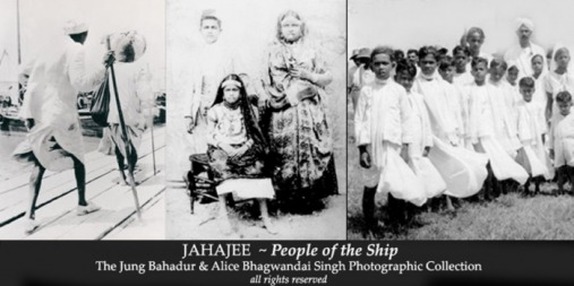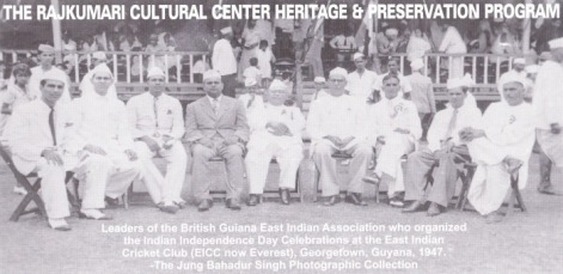Indo-Caribbeans in the United States by Karna Singh
After the abolition of African slavery in 1836, Asian Indians were brought to work as indentured laborers on European-owned colonial sugar plantations in Caribbean islands, such as Trinidad and Jamaica, and South American mainland countries, Guyana and Suriname. Their descendants, calleds Indo-Caribbeans, make up the majority populations in Guyana, Suriname and Trinidad. Since the 1960s, in a second wave of migration due to economic and political upheavals, many people fled to the United States, United Kingdom, Netherlands and Canada.
Migration, economic and political turmoil, poverty and exploitation have deeply scarred the Indo-Caribbean experience and ways of life. All things “coolie”, from food to spirituality, were scorned for generations by colonial and neo-colonial establishments; there was no interest or effort to understand the millennia of human experience and wisdom that created East Indian ways of life.
Rich varieties of culture and arts were brought to the New World from India by the indentured laborers. The majority of them came from the Hindi and Bhojpuri language region of northern India, modern Bihar and Uttar Pradesh; a much smaller group were from the Madras Tamil language region of southern India, modern Tamil Nadu. East Indians of Suriname continue to speak Hindi in everyday life, while in Trinidad and Guyana an English Creole vernacular with a strong Indic vocabulary replaced ancestral languages.
While absorbing diverse non-Indian influences in the social and cultural matrix of the region – European, African, popular American – the Indo-Caribbean people continue to cherish and nurture expressions of their ancestral heritage. The end of colonialism, the recession of an aggressive Eurocentricism, and a growing awareness of the global value of the cultural heritage have created a more nourishing environment for Indo-Caribbeans to preserve and share their traditions.
In the United States, Asian Indians from the South American/Caribbean region are called Indo-Caribbeans. Most of them live in the New York metropolitan and Tri-state area, with the highest concentration in the South Queens District (Richmond Hill, Ozone Park/Jamaica) and the Bronx (Grand Concourse/Castlehill districts). More recently, the Indo-Caribbean immigrant community in the U.S. has overcome the initial phase of disruption caused by immigration, and is rejuvenating its cultural and artistic life.
Migration, economic and political turmoil, poverty and exploitation have deeply scarred the Indo-Caribbean experience and ways of life. All things “coolie”, from food to spirituality, were scorned for generations by colonial and neo-colonial establishments; there was no interest or effort to understand the millennia of human experience and wisdom that created East Indian ways of life.
Rich varieties of culture and arts were brought to the New World from India by the indentured laborers. The majority of them came from the Hindi and Bhojpuri language region of northern India, modern Bihar and Uttar Pradesh; a much smaller group were from the Madras Tamil language region of southern India, modern Tamil Nadu. East Indians of Suriname continue to speak Hindi in everyday life, while in Trinidad and Guyana an English Creole vernacular with a strong Indic vocabulary replaced ancestral languages.
While absorbing diverse non-Indian influences in the social and cultural matrix of the region – European, African, popular American – the Indo-Caribbean people continue to cherish and nurture expressions of their ancestral heritage. The end of colonialism, the recession of an aggressive Eurocentricism, and a growing awareness of the global value of the cultural heritage have created a more nourishing environment for Indo-Caribbeans to preserve and share their traditions.
In the United States, Asian Indians from the South American/Caribbean region are called Indo-Caribbeans. Most of them live in the New York metropolitan and Tri-state area, with the highest concentration in the South Queens District (Richmond Hill, Ozone Park/Jamaica) and the Bronx (Grand Concourse/Castlehill districts). More recently, the Indo-Caribbean immigrant community in the U.S. has overcome the initial phase of disruption caused by immigration, and is rejuvenating its cultural and artistic life.
From 1838 to 1917, over half a million Indians from the former British Raj or British India, were taken to the Caribbean as Indentured workers to address the demand for labour following the abolition of slavery. The first two shiploads arrived in British Guiana (now Guyana) on May 5, 1838, which made 2008 the 170th anniversary.
The majority of the Indians living in the English-speaking Caribbean came from eastern Uttar Pradesh and western Bihar, while those brought to Guadeloupe and Martinique were mostly from, but not only, from Andhra Pradesh and Tamil Nadu.
A minority emigrated from other parts of South Asia, including present-day Pakistan and Bangladesh.
Indo-Caribbeans are the largest ethnic groups in Guyana and Suriname and are a plurality in Trinidad and Tobago. They are the second largest group in Jamaica, Grenada, Saint Vincent and the Grenadines, Saint Lucia, Martinique and Guadeloupe. There are also small populations in Anguilla, Antigua and Barbuda, The Bahamas, Barbados, Belize, French Guiana, Panama, Dominican Republic, Haiti and the Netherlands Antilles . There are also small groups often called "mulatts" who are of Indian descent in Haiti. Modern-day immigrants from India (mostly Sindhi merchants) are to be found on Saint-Martin / Sint Maarten, St. Thomas, Curaçao and other islands with duty-free commercial capabilities, where they are active in business. Other Indo-Caribbean people descend from later migrants, including Indian doctors, Gujarati businessmen and migrants from Kenya and Uganda. However, the vast majority are descendants of the original indentured workers.
Many Indo-Caribbean people have migrated to the United States of America, Canada, The Netherlands, France and the United Kingdom, and to other parts of the Caribbean. In Guadeloupe and Martinique, French West Indies, the commemoration of 150 years of Indian presence was celebrated officially by Indians and non-Indians during the whole year of 2003 and 2004 respectively.
The majority of the Indians living in the English-speaking Caribbean came from eastern Uttar Pradesh and western Bihar, while those brought to Guadeloupe and Martinique were mostly from, but not only, from Andhra Pradesh and Tamil Nadu.
A minority emigrated from other parts of South Asia, including present-day Pakistan and Bangladesh.
Indo-Caribbeans are the largest ethnic groups in Guyana and Suriname and are a plurality in Trinidad and Tobago. They are the second largest group in Jamaica, Grenada, Saint Vincent and the Grenadines, Saint Lucia, Martinique and Guadeloupe. There are also small populations in Anguilla, Antigua and Barbuda, The Bahamas, Barbados, Belize, French Guiana, Panama, Dominican Republic, Haiti and the Netherlands Antilles . There are also small groups often called "mulatts" who are of Indian descent in Haiti. Modern-day immigrants from India (mostly Sindhi merchants) are to be found on Saint-Martin / Sint Maarten, St. Thomas, Curaçao and other islands with duty-free commercial capabilities, where they are active in business. Other Indo-Caribbean people descend from later migrants, including Indian doctors, Gujarati businessmen and migrants from Kenya and Uganda. However, the vast majority are descendants of the original indentured workers.
Many Indo-Caribbean people have migrated to the United States of America, Canada, The Netherlands, France and the United Kingdom, and to other parts of the Caribbean. In Guadeloupe and Martinique, French West Indies, the commemoration of 150 years of Indian presence was celebrated officially by Indians and non-Indians during the whole year of 2003 and 2004 respectively.
* U.S. Census Bureau: South Asian Population:
A report released in 2003 by the U.S. Census Bureau shows the South Asian population increased by 106% in the U.S. from 1990 to 2000. Asian Indians more than doubled - from 815,447 in 1990 to 1,678,765 - ten years later. The Bangladeshi population rose about two and a half times from 11,838 to 41,280, while the Pakistani population increased from 81,371 to 153,533 in the decade. Sri Lankans went from 10,970 in 1990 to 20,145 in 2000. The Indo-Caribbean population of Guyana, Suriname, Trinidad and other CaribbeanIslands represents 20% of US Census Bureau Total South Asian Population.
*Statistics: Permanent and Undocumented Residents, and U.S. Citizens listed as “Other”, not include.
A report released in 2003 by the U.S. Census Bureau shows the South Asian population increased by 106% in the U.S. from 1990 to 2000. Asian Indians more than doubled - from 815,447 in 1990 to 1,678,765 - ten years later. The Bangladeshi population rose about two and a half times from 11,838 to 41,280, while the Pakistani population increased from 81,371 to 153,533 in the decade. Sri Lankans went from 10,970 in 1990 to 20,145 in 2000. The Indo-Caribbean population of Guyana, Suriname, Trinidad and other CaribbeanIslands represents 20% of US Census Bureau Total South Asian Population.
*Statistics: Permanent and Undocumented Residents, and U.S. Citizens listed as “Other”, not include.


